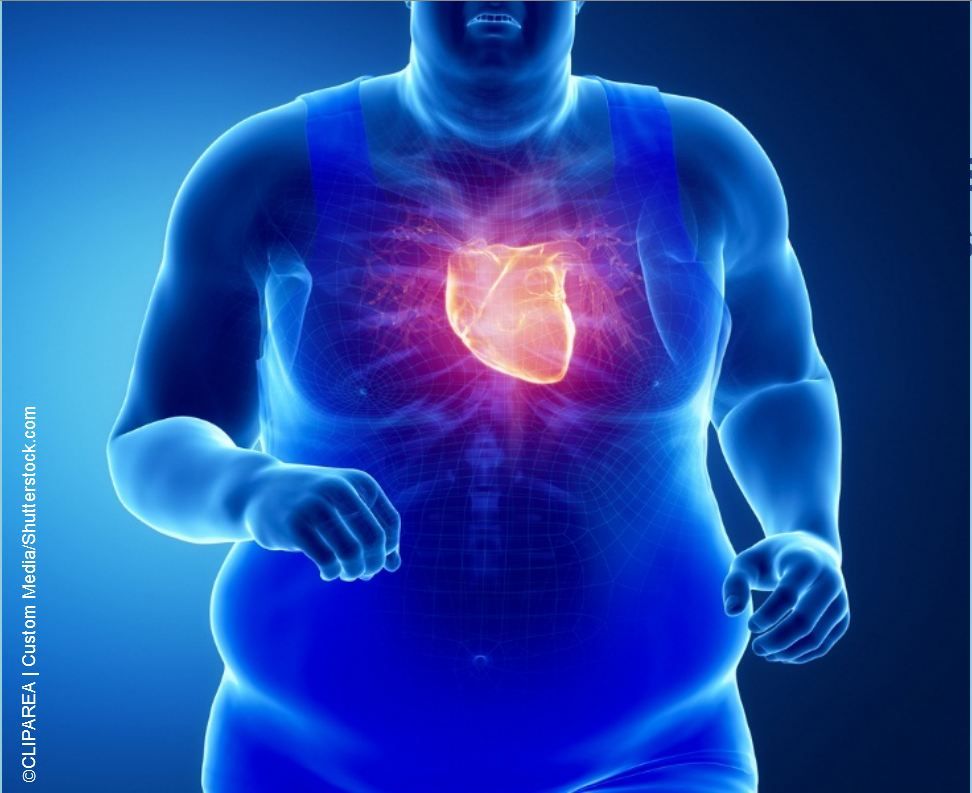- Clinical Technology
- Adult Immunization
- Hepatology
- Pediatric Immunization
- Screening
- Psychiatry
- Allergy
- Women's Health
- Cardiology
- Pediatrics
- Dermatology
- Endocrinology
- Pain Management
- Gastroenterology
- Infectious Disease
- Obesity Medicine
- Rheumatology
- Nephrology
- Neurology
- Pulmonology
Overweight, Obesity Overlooked in Secondary CHD Prevention, Study Finds
Patients with overweight and obesity rarely received guidance on weight management after hospitalization for a coronary event, authors report.
©Sebastian Kaulitzky/stock.adobe.com

Nearly a year and a half after hospitalization for a first or recurrent cardiac event, 86% of patients who had obesity during that hospitalization remained obese and 14% of patients who had been overweight became obese, according to a study published in European Heart Journal – Quality of Care and Clinical Outcomes. Young women were particularly affected, with nearly half of those aged <55 years being obese.
Led by Dirk De Bacquer, Department of Public Health and Primary Care, Ghent University, Belgium, the investigators also found that despite obesity being known in 80% of the patients at hospital admission, and a significant prevalence of comorbidities among them (eg, hypertension, hyperlipidemia, type 2 diabetes), weight status was not recorded in discharge letters for a quarter of the patients and a “substantial proportion” reported never having been told by a health care professional that they were overweight.
Citing the widening gap between recommendations from the Joint European Societies guidelines on primary and secondary CVD prevention and “alarming” increases in obesity and central adiposity, the authors sought to characterize specific management of CHD patients who were overweight/obese at an index CHD event in relation to lifestyle advice received, actions taken, and the relationship between weight changes and health status.
Authors used data pooled from the EUROASPIRE IV (2012 to 2013) and EUROASPIRE V (2016 to 2017) studies. Originally, 16 259 consecutive CHD patients were identified from hospital discharge lists or diagnostic registers. All had been admitted at least 6 months earlier for a first/recurrent diagnosis of acute myocardial infarction or acute myocardial ischemia, or for treatment with elective or emergency coronary artery bypass graft surgery (CABG) or percutaneous coronary intervention (PCI).
Final analysis included 10 507 patients for whom there was valid anthropometric data at the time of hospitalization. Follow-up visits were made to patients between 6 and 24 months (mean, 16 months) after hospital discharge for their cardiac event. During the visit, patients were interviewed, completed questionnaires, and received a clinical examination including weight, height, and laboratory tests.
Of the total group, 24.8% were women and average age was 62.5 years. At the time of hospital admission, 34.9% of patients were obese (BMI ≥30 kg/m2) and 46% were overweight (BMI 25-30 kg/m2). Less than 20% of CHD patients had BMI within normal limits. Women were more frequently obese than men. The prevalence of morbid obesity (BMI ≥40 kg/m2) was 2.2% (men 1.8%; women 3.6%). Age-standardized prevalence of obesity ranged from 8% to 46% in men and from 18% to 57% in women.
Weight change
At the time of follow-up study visits a greater proportion of patients were obese (36.9%). Obesity rates were higher in younger patients with a prevalence of 40.1% in those aged <55 years (men 38.3%, women 48.4%).
When the authors evaluated the link between weight changes and health status, the found that those who were overweight or obese and had lost ≥5% of their discharge body weight had significantly lower levels of hypertension, dyslipidemia, and unrecognized diabetes vs those who had gained ≥5% or more of their body weight. Investigators note that all patients were being equally treated with antihypertensive and lipid-lowering medications. The weight loss group also reported higher levels of physical and emotional quality of life (QoL).
Advice
Approximately 50% of patients were advised to follow a cardiac prevention and rehabilitation program. There was no difference in regimen prescribed based on weight status. Less than two-thirds of obese patients were prescribed dietary recommendations (63.7%) or to participate in regular physical activity (64.2%).
Lifestyle
Improved lifestyle factors were positively associated with weight loss among both overweight and obese patients. Compared to those who gained ≥5% of their body weight, those who lost at least 5% more frequently reported reduced fat and sugar intake, increased consumption of fruit, vegetables, and fish, increased physical activity, regular attendance at cardiac rehabilitation, and following a clinician’s dietary advice.
The authors noted that weight gain was significantly associated with smoking cessation. In patients who were overweight or obese when hospitalized, those who quit smoking gained 1.8 kg on average in contrast to the 0.4 kg average weight gain observed in persistent smokers.
From the authors
“Uptake and access to cardiac rehabilitation programmes is poor with less than half of patients across Europe reporting that they completed a programme,” said study author Professor Catriona Jennings, National Institute for Prevention and Cardiovascular Health, National University of Ireland, in a press statement. “Such programmes would provide a good opportunity to support patients in addressing overweight and obesity, especially for female patients who were found to have the biggest problem with overweight and obesity in the study.
"Uptake and access could be improved," Jennings suggests, "with the use of digital technology, especially for women, who possibly are less likely to attend a programme because they have many other competing priorities, such as caring for others. There are good reasons for people to address their weight after a cardiac event. But it’s not easy and they do need help.”
Reference: De Bacquer D, , Jennings CS, Mirrakhimov E, et al. Potential for optimizing management of obesity in the secondary prevention of coronary heart disease. Eur Heart J Qual Care Clin Outcomes. Published online July 27, 2021. https://doi.org/10.1093/ehjqcco/qcab043.
